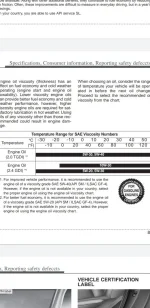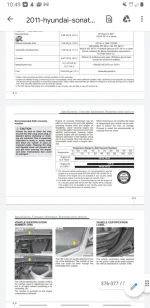You are using an out of date browser. It may not display this or other websites correctly.
You should upgrade or use an alternative browser.
You should upgrade or use an alternative browser.
Can thicker oil prevent rocker arm failures in Pentastar 3.6 V6?
- Thread starter easym
- Start date
Yes, you can never overcome poor mechanical engineering with lubricant engineering. It may ameliorate it for a short period of time, but sooner or later you’re going to pay for some dumb engineer’s shortcut or penny pincher’s $.03 savings.Oil alone isn't going to fix any engines deficiencies. Period.
- Joined
- Sep 26, 2010
- Messages
- 9,837
I never said that it didn't. What I said was:Where’s the proof that 0w20 doesn’t perform as 5w30 off roading?
"I like the increased protection that it provides over 0W-20 especially when off-roading in high temperatures."
Big difference in what I actually said versus what you read into what I said.
- Joined
- Nov 2, 2021
- Messages
- 1,116
Again, how do you know you're getting increased protection? I'm not looking or reading into it any differently. Is there actual evidence in the breakdown of two engines and a comparison was made against wear?"I like the increased protection that it provides over 0W-20 especially when off-roading in high temperatures."
Big difference in what I actually said versus what you read into what I said.
Anyone that understands the relationship between HTHS viscosity, MOFT and wear (basic Tribology) knows why there would be increased protection. There's a difference between "adequate" or "borderline" protection vs "increased protection".
Last edited:
All these posts...but…
Did we answer the OP’s question?
Because, in his case, the answer seems to be “No, the rocker arm failures are material in nature”.
Did we answer the OP’s question?
Because, in his case, the answer seems to be “No, the rocker arm failures are material in nature”.
OP I would go with the OEM recommendations for oil in your vehicle. I have a 2014 Jeep with the Pentastar engine and it has 75,000 miles on it. I have ran the 0W20 since 25,000 miles and have not had any problems and you can barely hear the engine run at idle. I believe if you run the correct oil that the manufacturer recommends you will be fine for 200,000 miles or longer. Personally I try to change the oil in my Jeep at about 5,000 miles and I use Mobile 1 oil filters on this vehicle. I do not believe in running thicker oils in this engine.
Although I agree with the fact that Mopar has valvetrain issues, higher zinc oil will help. If you don’t have an oil burner, the zinc won’t clog a catalytic converter as “they” want you to believe. Our Fleet is primarily Dodge Charger with the V6 and the most common failures have been after 100k. These aren’t easy miles but 6,500 mile oil change intervals help also.
- Joined
- Sep 26, 2010
- Messages
- 9,837
@ZeeOSix explained it very well twice in this thread--no need for me to belabor the point:Again, how do you know you're getting increased protection? I'm not looking or reading into it any differently. Is there actual evidence in the breakdown of two engines and a comparison was made against wear?
Anyone that understands the relationship between HTHS viscosity, MOFT and wear (basic Tribology) knows why there would be increased protection. There's a difference between "adequate" or "borderline" protection vs "increased protection".
I'd take the protection of PAO over just a weight grade for that. Mobil 1 EP 0w20 has a higher percentage of PAO in the base than anything else I've seen. And its flash point is much higher than the same brand 5w30. I've read that Noack is pretty low on the 0w20, as well. I'd bet it is close to the 5w30. Then there's the little point that my 3.6 Pentastar (PUG versions) engines were developed from the start with 0w20.I never said that it didn't. What I said was:
"I like the increased protection that it provides over 0W-20 especially when off-roading in high temperatures."
Big difference in what I actually said versus what you read into what I said.
But besides that, the temperature inside the engine won't be an issue if your cooling system is functioning properly. I've been off road in the desert in temps over 100 degrees and also in the midwest in the winter in temps in the teens. In both cases, when crawling along at slow speeds in 4wd low, the engine oil temp maxed out at about 224 degrees and the fluctuations were about the same. That's nowhere near the stress pretty much any full syn 0w20 can handle, with a wide margin to spare.
- Joined
- Sep 26, 2010
- Messages
- 9,837
I have seen 240°F+ in mine--plenty of reasons that could happen and operating conditions is not the least of it. I am not trying to sell or convince anyone to run a certain viscosity oil.I'd take the protection of PAO over just a weight grade for that. Mobil 1 EP 0w20 has a higher percentage of PAO in the base than anything else I've seen. And its flash point is much higher than the same brand 5w30. I've read that Noack is pretty low on the 0w20, as well. I'd bet it is close to the 5w30. Then there's the little point that my 3.6 Pentastar (PUG versions) engines were developed from the start with 0w20.
But besides that, the temperature inside the engine won't be an issue if your cooling system is functioning properly. I've been off road in the desert in temps over 100 degrees and also in the midwest in the winter in temps in the teens. In both cases, when crawling along at slow speeds in 4wd low, the engine oil temp maxed out at about 224 degrees and the fluctuations were about the same. That's nowhere near the stress pretty much any full syn 0w20 can handle, with a wide margin to spare.
Everyone can run whatever they want, but at the same time, no one can deny the laws of physics (unless they are oblivious to them or just chooses to refuse to believe them). xW-30 affords more protection than xW-20, plain and simple.
Last edited:
I gave that video 1 minute....no way I can sit through 16 minutes of empty rambling.
D
Deleted member 89374
Please post a screenshot of that section of the owner's manual or a picture. Thank you.Why then did my hyundai manual say "for added performance use 5w-40"
You are corect, many off-the-shelft D1G2/3 type oils will shear from 5W-30 down to a 5W-20, not 0W-20. I'm making the distinction because of the winter rating, as that can't possibly change. This happens dur to thin base oils and cheap VII.All oils shear to a degree and 5W-30 will typically shear into a thick 0W-20 so I cannot see how it could possibly hurt--I have not had any issues in 50K miles and after 100K on 0W-40, my friend's Pentastar is still trucking right along.
If you want a strong 5W-30 D1G2/3 type oil that won't shear down, then you should know that HPL makes that.
D
Deleted member 89374
The problem with his ramble is that the VVT in the Pentastar will chocke on that oil. Let's just say that rough idle would be the least of his problems. I wonder how that chain driven oil pump lives on that 10W-60This guy uses 10W60 in his pentastar and swears he never had any rocker failures.
How can I say this nicely? Sorry, I can't. That guy is full of it.
- Joined
- Sep 26, 2010
- Messages
- 9,837
I normally write xW-30 or xW-20 and did not in that post and you are correct.You are corect, many off-the-shelft D1G2/3 type oils will shear from 5W-30 down to a 5W-20, not 0W-20. I'm making the distinction because of the winter rating, as that can't possibly change. This happens dur to thin base oils and cheap VII.
Common sense.How did you come to this conclusion?
Are you inferring the oil keeps the parts separated?Because apparently he understands the basics that wear correlates to MOFT, and that higher viscosity gives more MOFT. Call it "added protection" because you have more MOFT between moving parts to work with before metal-to-metal contact occurs. Higer MOFT headroom is added insurance to minimize wear.
Here ya go. Rod..Please post a screenshot of that section of the owner's manual or a picture. Thank you.
You are corect, many off-the-shelft D1G2/3 type oils will shear from 5W-30 down to a 5W-20, not 0W-20. I'm making the distinction because of the winter rating, as that can't possibly change. This happens dur to thin base oils and cheap VII.
If you want a strong 5W-30 D1G2/3 type oil that won't shear down, then you should know that HPL makes that.
Attachments
D
Deleted member 89374
Yep, that's what it says. Our 2017 Santa Fe 3.3L V6 also allows for 5W-40, but they removed the line about "for added performance use 5W-40". Hyundai engines can't really run well on low viscosity oils.Here ya go. Rod..
Similar threads
- Replies
- 52
- Views
- 3K
- Replies
- 10
- Views
- 895
- Replies
- 22
- Views
- 3K
- Replies
- 8
- Views
- 434



